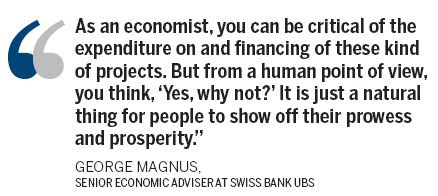Lasting legacy
Updated: 2011-12-30 08:51
By Andrew Moody (China Daily)
|
||||||||

|
|
Big ticket, new-age projects to help China establish a permanent footprint on global center stage
Do countries need large-scale projects to announce their arrival on the world stage as a major economic force?
China is currently investing billions on major infrastructure development, groundbreaking architectural projects and in science and technology in such futuristic fields as space exploration, supercomputers and robotics.
The world's second-largest economy is not the first to make such bold statements.
Even the Greeks when building the Parthenon in the 5th century BC wanted to create something that would be a lasting legacy of their society.
|
||||
The Americans announced their emerging economic power by the construction of vast skyscrapers such as the 102-story Empire State Building, which after being completed in 1931 was the world's tallest building for 40 years.
Their achievements did not just stop there. The pinnacle was arguably the most impressive scientific achievement of all time, the landing of a man on the moon in July 1969.
Some argue that China's recent investment in major projects has been excessive and has led to heavy local government debt.
China's National Audit Office reported in June that local government debt had reached $1.7 trillion (1.3 trillion euros), some 27 percent of the country's gross domestic product.
But one of the major questions is whether big projects are just a country showing off its new status in the world or an inevitable by-product and consequence of just being a strong economic force in the world.
Martin Jacques, the British academic and journalist and author of When China Rules the World, which argues that China would become the dominant power in the 21st century, believes all emerging societies like to put themselves on the map with big projects.
"I think most seriously rising societies have at some point had big projects. I think it goes with the territory and is not just reducible to some prestige or reputational purpose."
In this issue, we look at 10 of China's great projects of the early 21st century and assess their value and whether they are symbols of the former Middle Kingdom's new world status.
These include the world's longest sea bridge, spanning some 36 kilometers across the mouth of the Jiaozhou Bay in eastern Shandong province and which would easily cross the English Channel, and also the 606-meter skyscraper in Wuhan, the capital of Hubei province, which when completed will be the third-tallest building in the world.
We also feature the over-1,000 km 350 km/h high-speed railway from Wuhan to Guangzhou, which reduced the traveling time between the two cities from 11 to just three hours.
It will eventually form part of a 2,100 km link between Beijing and the capital of Guangdong province.
Another major project is the 1,800 seating capacity Guangzhou Opera House designed by the British architect Zaha Hadid at a cost of 1.38 billion yuan ($218 million, 168 million euros).
We also highlight developments in China subway systems, focusing on Wuhan, where the first line has been built but others - which will be among the most advanced in the world - are currently under construction.






















